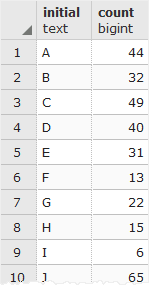PostgreSQL LEFT() Function
The PostgreSQL LEFT() function returns the first n characters in the string.
Syntax
The following illustrates the syntax of the PostgreSQL LEFT() function:
LEFT(string, n)Arguments
The PostgreSQL LEFT() function requires two arguments:
1) string
is a string from which a number of the leftmost characters returned.
2) n
is an integer that specifies the number of left-most characters in the string should be returned.
If n is negative, the LEFT() function returns the leftmost characters in the string but last |n| (absolute) characters.
Return value
The PostgreSQL LEFT() function returns the first n characters in a string.
Examples
Let’s look at some examples of using the LEFT() function.
The following example shows how to get the first character of a string 'ABC':
SELECT LEFT('ABC',1);The result is
left
------
A
(1 row)To get the first two characters of the string ‘ABC’, you use 2 instead of 1 for the n argument:
SELECT LEFT('ABC',2);Here is the result:
left
------
AB
(1 row)The following statement demonstrates how to use a negative integer:
SELECT LEFT('ABC',-2);In this example, n is -2, therefore, the LEFT() function return all character except the last 2 characters, which results in:
left
------
A
(1 row)See the following customer table in the sample database:
The following statement uses the LEFT() function to get the initials and the COUNT() function to return the number of customers for each initial.
SELECT LEFT(first_name, 1) initial,
COUNT(*)
FROM customer
GROUP BY initial
ORDER BY initial;In this example, first, the LEFT() function returns initials of all customers. Then, the GROUP BY clause groups customers by their initials. Finally, the COUNT() function returns the number of customer for each group.

Remarks
If you want to get the n rightmost characters, please see the RIGHT() function for the details.
In this tutorial, you have learned how to use the PostgreSQL LEFT() function to get the n left-most characters in a string.